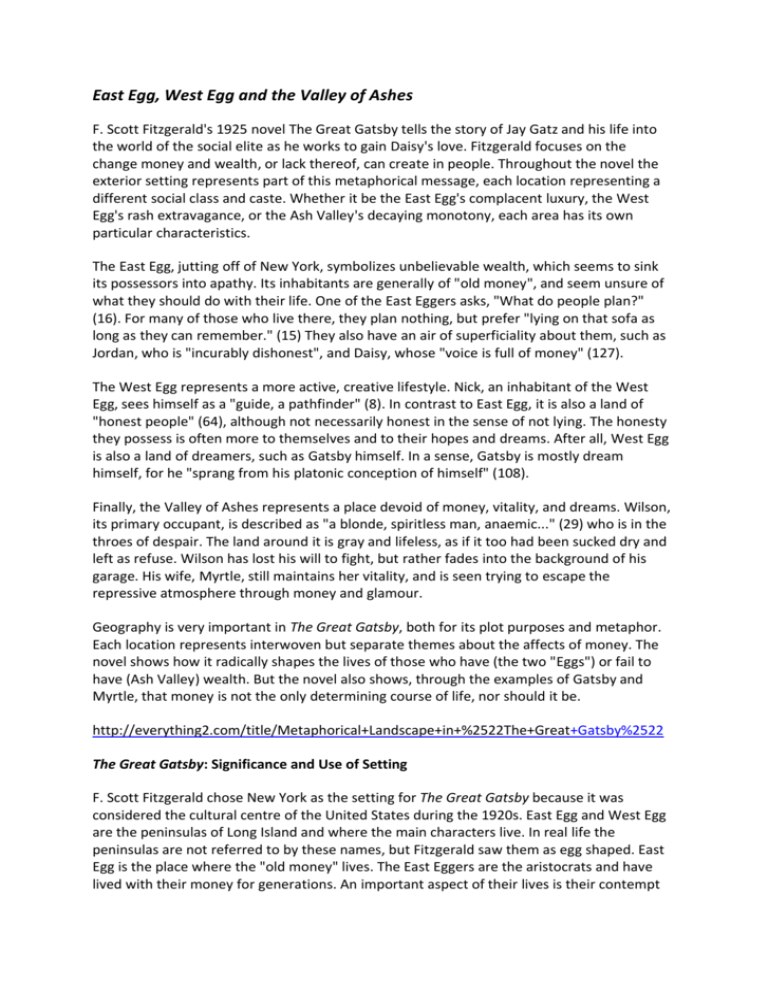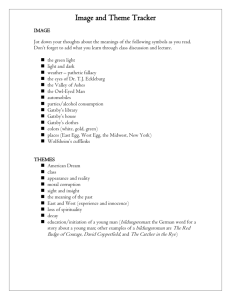East Egg, West Egg and the Valley of Ashes - Texts-In-Time
advertisement

East Egg, West Egg and the Valley of Ashes F. Scott Fitzgerald's 1925 novel The Great Gatsby tells the story of Jay Gatz and his life into the world of the social elite as he works to gain Daisy's love. Fitzgerald focuses on the change money and wealth, or lack thereof, can create in people. Throughout the novel the exterior setting represents part of this metaphorical message, each location representing a different social class and caste. Whether it be the East Egg's complacent luxury, the West Egg's rash extravagance, or the Ash Valley's decaying monotony, each area has its own particular characteristics. The East Egg, jutting off of New York, symbolizes unbelievable wealth, which seems to sink its possessors into apathy. Its inhabitants are generally of "old money", and seem unsure of what they should do with their life. One of the East Eggers asks, "What do people plan?" (16). For many of those who live there, they plan nothing, but prefer "lying on that sofa as long as they can remember." (15) They also have an air of superficiality about them, such as Jordan, who is "incurably dishonest", and Daisy, whose "voice is full of money" (127). The West Egg represents a more active, creative lifestyle. Nick, an inhabitant of the West Egg, sees himself as a "guide, a pathfinder" (8). In contrast to East Egg, it is also a land of "honest people" (64), although not necessarily honest in the sense of not lying. The honesty they possess is often more to themselves and to their hopes and dreams. After all, West Egg is also a land of dreamers, such as Gatsby himself. In a sense, Gatsby is mostly dream himself, for he "sprang from his platonic conception of himself" (108). Finally, the Valley of Ashes represents a place devoid of money, vitality, and dreams. Wilson, its primary occupant, is described as "a blonde, spiritless man, anaemic..." (29) who is in the throes of despair. The land around it is gray and lifeless, as if it too had been sucked dry and left as refuse. Wilson has lost his will to fight, but rather fades into the background of his garage. His wife, Myrtle, still maintains her vitality, and is seen trying to escape the repressive atmosphere through money and glamour. Geography is very important in The Great Gatsby, both for its plot purposes and metaphor. Each location represents interwoven but separate themes about the affects of money. The novel shows how it radically shapes the lives of those who have (the two "Eggs") or fail to have (Ash Valley) wealth. But the novel also shows, through the examples of Gatsby and Myrtle, that money is not the only determining course of life, nor should it be. http://everything2.com/title/Metaphorical+Landscape+in+%2522The+Great+Gatsby%2522 The Great Gatsby: Significance and Use of Setting F. Scott Fitzgerald chose New York as the setting for The Great Gatsby because it was considered the cultural centre of the United States during the 1920s. East Egg and West Egg are the peninsulas of Long Island and where the main characters live. In real life the peninsulas are not referred to by these names, but Fitzgerald saw them as egg shaped. East Egg is the place where the "old money" lives. The East Eggers are the aristocrats and have lived with their money for generations. An important aspect of their lives is their contempt for so called "new money" and their feelings that these neophytes could eventually cause the downfall of the aristocratic society. The West Eggers are the "new money" that the East Eggers resent. They are all lower and middle class people who have found themselves with outrageous amounts of money, and as a result spend it in an outrageous manner. Daisy has never gone to one of Gatsby's parties because she hates being around West Eggers. Fitzgerald chose this clear separation between old and new to mirror East and West. The people of the East considered the Western United States the barbaric frontier. The country was just beginning to grow in the West and as a result it was viewed as young and immature. The West Eggers are the new money and are viewed just as the frontier is, young and immature. Another interesting fact is that all of the main characters are not native to New England. Gatsby grew up in North Dakota. Most of the rest grew up in Louisville, Kentucky. The characters could all be considered westerners, or outsiders. Fitzgerald used this as another East-West comparison. The Westerners moving east are trying to make new lives for themselves and leave the immature West behind. A very important place in the novel is the "Valley of Ashes." This desolate wasteland is located on the way to New York from East or West Egg. It is the location of George Wilson's garage and is also the site of Myrtle's demise. The billboard of Dr. T. J. Eckleburg, a symbolic reference to God, is also located in the valley of ashes. The valley represents modern society and the destruction that it causes. The ashes are a byproduct of the trains and represent a poisoning of the American landscape. The valley is essentially a dumping ground for modern, industrial, toxic waste. http://www.fcps.edu/westspringfieldhs/academic/english/1project/99gg/99gg6/setting.ht m



